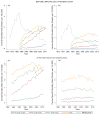Understanding Treatment Disconnect and Mortality Trends in Renal Cell Carcinoma Using Tumor Registry Data
- PMID: 27820596
- PMCID: PMC5352513
- DOI: 10.1097/MLR.0000000000000657
Understanding Treatment Disconnect and Mortality Trends in Renal Cell Carcinoma Using Tumor Registry Data
Abstract
Background and objectives: The paradoxical rise in overall and cancer-specific mortality despite increased detection and treatment of renal cell carcinoma (RCC) is termed "treatment disconnect." We reassess this phenomenon by evaluating impact of missing data and rising incidence on mortality trends.
Research design, subjects, and measures: Using Surveillance, Epidemiology, and End Results data, we identified patients with RCC diagnosis from 1973 to 2011. We estimated mortality rates by tumor size after accounting for lags from diagnosis to death using multiple imputations for missing data from 1983. Mortality rates were estimated irrespective of tumor size after adjustment for prior cumulative incidence using ridge regression.
Results: A total of 78,891 patients met inclusion criteria. Of 70,212 patients diagnosed since 1983, 10.4% had missing data. Significant attenuation in cancer-specific mortality was noted from 1983 to 2011 when comparing observed with imputed rates: Δobs0.05 versus Δimp0.10 (P=0.001, <2 cm tumors); Δobs0.29 versus Δimp0.18 (P=0.005, 2-4 cm tumors); Δobs0.46 versus Δimp-0.20 (P<0.001, 4-7 cm tumors); Δobs0.93 versus Δimp-0.15 (P<0.001, >7 cm tumors). Holding incidence of RCC constant to 2011 rates, temporal increase in overall mortality for all patients was attenuated (P<0.001) when comparing observed estimates (3.9-6.8) with 2011 adjusted estimates (5.9-7.1), suggesting that rapidly rising incidence may influence reported overall mortality trends. These findings were supported by assessment of mortality to incidence ratio trends.
Conclusions: Missing data and rising incidence may contribute substantially to the "treatment disconnect" phenomenon when examining mortality rates in RCC using tumor registry data. Caution is advised when basing clinical and policy decisions on these data.
Conflict of interest statement
Marc C Smaldone, Brent K. Hollenbeck, John M. Hollingsworth, David Miller, Todd Morgan, Simon Kim, Aseem Malhotra, Robert Uzzo, and Alexander Kutikov have no conflicts of interest to disclose.
Brian Egleston serves as a consultant/advisor for Teva and receives salary support via institution (Janssen and Verilogue).
Elizabeth Handorf and Yu-Ning Wong receive research support paid to the institution via Pfizer. Yu-Ning Wong receives travel support from Tokia.
Figures




References
-
- Siegel R, Miller K, Jemal A. Cancer statistics, 2016. CA Cancer J Clin. 2016;66(1):7–30. - PubMed
-
- Chow WH, et al. Rising incidence of renal cell cancer in the United States. JAMA. 1999;281(17):1628–31. - PubMed
-
- Simard EP, et al. Cancers with increasing incidence trends in the United States: 1999 through 2008. CA Cancer J Clin. 2012;62(2):118–28. - PubMed
-
- Hollingsworth JM, et al. Rising incidence of small renal masses: a need to reassess treatment effect. J Natl Cancer Inst. 2006;98(18):1331–4. - PubMed
-
- Parsons JK, Schoenberg MS, Carter HB. Incidental renal tumors: casting doubt on the efficacy of early intervention. Urology. 2001;57(6):1013–5. - PubMed
Publication types
MeSH terms
Grants and funding
LinkOut - more resources
Full Text Sources
Other Literature Sources
Medical
Miscellaneous

